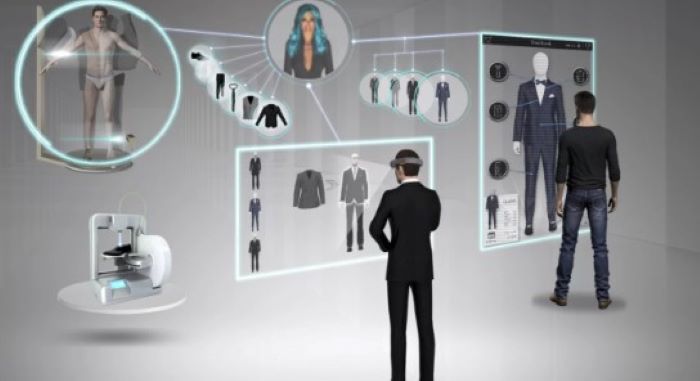3D tech in fashion opens new doors of opportunity for greater innovations

Raghav Mittal
Fashion, like a chameleon, is always adapting and reinventing itself to stay relevant, constantly exploring new possibilities and expanding its horizons. Similarly, the use of 3D technology in fashion is becoming increasingly popular, as it offers designers and manufacturers the ability to create intriguing and enchanting designs with precision and efficiency.
3D technology has revolutionized the fashion industry by allowing designers to create more intricate designs, explore new materials and techniques, and experiment with different shapes and forms. With 3D modelling software, designers can create realistic digital prototypes of their silhouettes, which can be easily modified and adapted to suit different requirements. In addition to time and cost savings, the utilization of 3D technology in fashion design also contributes to environmental sustainability by minimizing waste and reducing the carbon footprint during processing and dying.
One of the principal benefits of using 3D technology in fashion is the ability to create bespoke designs. With 3D scanning technology, designers can create a digital model of a person’s body, which can then be used to create custom-fitted garments. This is particularly useful for people with non-standard body shapes or sizes, as it allows them to have clothing that fits perfectly and enhances their confidence.
Another advantage of 3D technology is the ability to create complex patterns and textures. With traditional methods, creating intricate patterns or textures can be time-taking and require a high level of skills. However, with 3D printing, designers can create numerous patterns and textures with ease, resulting in unique and innovative designs.
Furthermore, 3D printing allows designers to experiment with different materials and create sustainable fashion. In recent years, there has been a burgeoning interest in sustainable fashion, and 3D printing offers a way to create clothing that is both eco-friendly and fashionable. By using recycled or biodegradable materials, designers can create clothing that has a lower environmental impact and reduced wastage.
3D technology has also made it easier to manufacture clothing on a large scale. With traditional methods, mass production of apparel and textile can be a time-consuming and costly process. However, with 3D printing, designers can create digital files of their designs, which can then be sent to manufacturers to produce garments in volumes.
This strategy offers a multitude of benefits apart from expediting the production process, curtailing costs, and reducing waste. Besides, the integration of 3D modelling with the existing Product Lifecycle Management (PLM) software leads to enhanced team efficiency and collaboration. This integration allows marketing professionals, design experts, sustainability specialists, and managers to cultivate their insights in a rather dynamic manner, resulting in streamlined production processes and the creation of high-quality products.
3D technology is also being used to create virtual fashion shows. With the COVID-19 pandemic disrupting the fashion industry, many designers have turned to virtual shows as a way to showcase their collections. Using 3D technology, designers can create virtual fashion shows that are interactive and engaging, allowing viewers to experience the collection in a unique way. Furthermore, the benefits of 3D technology in the fashion industry are not limited to designers alone.
Logistics and supply chains for fashion brands can also benefit from 3D technology, resulting in more efficient and responsive processes for delivering designs to customers. In particular, smaller labels have traditionally relied on partnerships with retailers to showcase their designs and build their brands. This approach not only benefits the label’s partnerships with retailers but also reduces promotion costs.
In addition to a host of benefits, there are also certain challenges associated with 3D technology. One of the foremost challenges is the cost of equipment and software. While 3D printing technology has become more affordable in recent years, it is still relatively expensive, making it difficult for smaller designers or brands to invest in the technology. Another challenge is the need for skilled professionals. While 3D modelling software has become more user-friendly, it still requires a certain level of skills and expertise. This means that designers and manufacturers must invest in training and development to ensure they have the necessary technical skills.
Nevertheless, fashion brands are increasingly leveraging 3D technology to transform customer interactions. Interactive ads and apps using 3D designs are becoming more popular and are challenging traditional video and static advertisements. The most innovative brands utilize 3D design to prepare for the Metaverse, a virtual reality space where physical and virtual experiences are seamlessly blended. With NFT (non-fungible token) garments gaining enormous value and the possibility of digital fashion becoming mainstream, fashion brands are exploring combining physical and virtual 3D designs to enhance their profits.
In gist
3D tech offers significant opportunities for innovation in the fashion industry. From creating custom designs and experimenting with materials to reducing waste and environmental impact, 3D technology is changing the way we approach fashion design and production. Moreover, with the growing interest in sustainable fashion and the increasing demand for custom-made designs, 3D technology is expected to play a path-breaking role in the fashion industry in the years to come.
Raghav Mittal is MD & Creative Director, House of Surya


